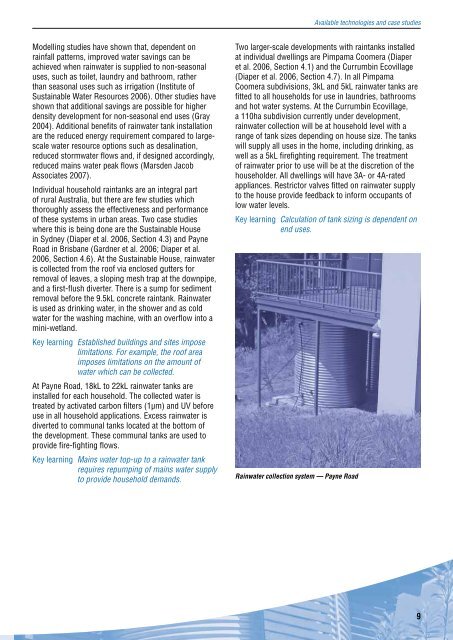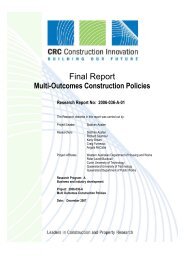Sustainable subdivisions - Construction Innovation
Sustainable subdivisions - Construction Innovation
Sustainable subdivisions - Construction Innovation
- No tags were found...
You also want an ePaper? Increase the reach of your titles
YUMPU automatically turns print PDFs into web optimized ePapers that Google loves.
Available technologies and case studiesModelling studies have shown that, dependent onrainfall patterns, improved water savings can beachieved when rainwater is supplied to non-seasonaluses, such as toilet, laundry and bathroom, ratherthan seasonal uses such as irrigation (Institute of<strong>Sustainable</strong> Water Resources 2006). Other studies haveshown that additional savings are possible for higherdensity development for non-seasonal end uses (Gray2004). Additional benefi ts of rainwater tank installationare the reduced energy requirement compared to largescalewater resource options such as desalination,reduced stormwater fl ows and, if designed accordingly,reduced mains water peak fl ows (Marsden JacobAssociates 2007).Individual household raintanks are an integral partof rural Australia, but there are few studies whichthoroughly assess the effectiveness and performanceof these systems in urban areas. Two case studieswhere this is being done are the <strong>Sustainable</strong> Housein Sydney (Diaper et al. 2006, Section 4.3) and PayneRoad in Brisbane (Gardner et al. 2006; Diaper et al.2006, Section 4.6). At the <strong>Sustainable</strong> House, rainwateris collected from the roof via enclosed gutters forremoval of leaves, a sloping mesh trap at the downpipe,and a fi rst-fl ush diverter. There is a sump for sedimentremoval before the 9.5kL concrete raintank. Rainwateris used as drinking water, in the shower and as coldwater for the washing machine, with an overfl ow into amini-wetland.Key learning Established buildings and sites imposelimitations. For example, the roof areaimposes limitations on the amount ofwater which can be collected.At Payne Road, 18kL to 22kL rainwater tanks areinstalled for each household. The collected water istreated by activated carbon fi lters (1µm) and UV beforeuse in all household applications. Excess rainwater isdiverted to communal tanks located at the bottom ofthe development. These communal tanks are used toprovide fi re-fi ghting fl ows.Key learning Mains water top-up to a rainwater tankrequires repumping of mains water supplyto provide household demands.Two larger-scale developments with raintanks installedat individual dwellings are Pimpama Coomera (Diaperet al. 2006, Section 4.1) and the Currumbin Ecovillage(Diaper et al. 2006, Section 4.7). In all PimpamaCoomera <strong>subdivisions</strong>, 3kL and 5kL rainwater tanks arefi tted to all households for use in laundries, bathroomsand hot water systems. At the Currumbin Ecovillage,a 110ha subdivision currently under development,rainwater collection will be at household level with arange of tank sizes depending on house size. The tankswill supply all uses in the home, including drinking, aswell as a 5kL fi refi ghting requirement. The treatmentof rainwater prior to use will be at the discretion of thehouseholder. All dwellings will have 3A- or 4A-ratedappliances. Restrictor valves fi tted on rainwater supplyto the house provide feedback to inform occupants oflow water levels.Key learning Calculation of tank sizing is dependent onend uses.Rainwater collection system — Payne Road9
















